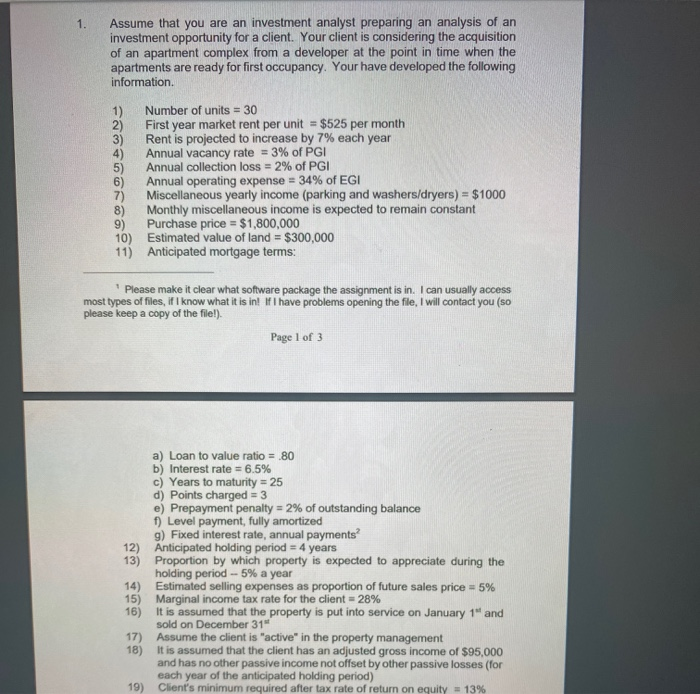1-19 are just information for the problem.
Numbrr 1 starts at a)

Assume that you are an investment analyst preparing an analysis of an investment opportunity for a client. Your client is considering the acquisition of an apartment complex from a developer at the point in time when the apartments are ready for first occupancy. Your have developed the following information. 1) 2) 3) 5) 6) 7) 8) 9) 10) Number of units = 30 First year market rent per unit = $525 per month Rent is projected to increase by 7% each year Annual vacancy rate = 3% of PGI Annual collection loss = 2% of PGI Annual operating expense = 34% of EGI Miscellaneous yearly income (parking and washers/dryers) = $1000 Monthly miscellaneous income is expected to remain constant Purchase price = $1,800,000 Estimated value of land = $300,000 Anticipated mortgage terms: Please make it clear what software package the assignment is in. I can usually access most types of files, if I know what it is in! If I have problems opening the file, I will contact you (so please keep a copy of the file!). Page 1 of 3 12) 13) a) Loan to value ratio = 80 b) Interest rate = 6.5% c) Years to maturity = 25 d) Points charged = 3 e) Prepayment penalty = 2% of outstanding balance f) Level payment, fully amortized g) Fixed interest rate, annual payments? Anticipated holding period = 4 years Proportion by which property is expected to appreciate during the holding period -5% a year Estimated selling expenses as proportion of future sales price 5% Marginal income tax rate for the client = 28% It is assumed that the property is put into service on January 1" and sold on December 31 Assume the client is "active" in the property management It is assumed that the client has an adjusted gross income of $95.000 and has no other passive income not offset by other passive losses (for each year of the anticipated holding period) Client's minimum required after tax rate of return on equity = 13% 14) 15) 16) 17) 18) 19) Calculate: a. The before-tax and after-tax cash flows for each year of the holding period and the before-tax and after-tax equity reversion. 0 The after-tax net present value and after-tax internal rate of return to the investor. c. The profitability index (this is calculated on an after-tax basis). Should we invest in this project? Explain. d. Assume that you are an investment analyst preparing an analysis of an investment opportunity for a client. Your client is considering the acquisition of an apartment complex from a developer at the point in time when the apartments are ready for first occupancy. Your have developed the following information. 1) 2) 3) 5) 6) 7) 8) 9) 10) Number of units = 30 First year market rent per unit = $525 per month Rent is projected to increase by 7% each year Annual vacancy rate = 3% of PGI Annual collection loss = 2% of PGI Annual operating expense = 34% of EGI Miscellaneous yearly income (parking and washers/dryers) = $1000 Monthly miscellaneous income is expected to remain constant Purchase price = $1,800,000 Estimated value of land = $300,000 Anticipated mortgage terms: Please make it clear what software package the assignment is in. I can usually access most types of files, if I know what it is in! If I have problems opening the file, I will contact you (so please keep a copy of the file!). Page 1 of 3 12) 13) a) Loan to value ratio = 80 b) Interest rate = 6.5% c) Years to maturity = 25 d) Points charged = 3 e) Prepayment penalty = 2% of outstanding balance f) Level payment, fully amortized g) Fixed interest rate, annual payments? Anticipated holding period = 4 years Proportion by which property is expected to appreciate during the holding period -5% a year Estimated selling expenses as proportion of future sales price 5% Marginal income tax rate for the client = 28% It is assumed that the property is put into service on January 1" and sold on December 31 Assume the client is "active" in the property management It is assumed that the client has an adjusted gross income of $95.000 and has no other passive income not offset by other passive losses (for each year of the anticipated holding period) Client's minimum required after tax rate of return on equity = 13% 14) 15) 16) 17) 18) 19) Calculate: a. The before-tax and after-tax cash flows for each year of the holding period and the before-tax and after-tax equity reversion. 0 The after-tax net present value and after-tax internal rate of return to the investor. c. The profitability index (this is calculated on an after-tax basis). Should we invest in this project? Explain. d









